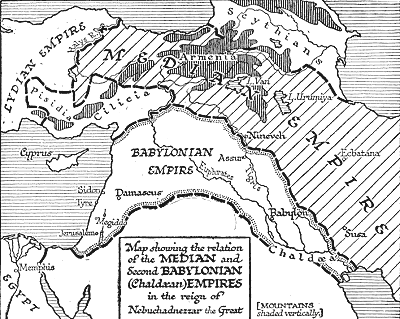It is now over a half century since a Russian politician and Scholar, Minorsky, suggested Kurds might have been descendants of two Median tribes (Kyrtioi and Mardioi) mentioned in classical Greek accounts. Although his theses was soon criticized thanks two progress in the studies on Iranic languages, however, it was kept alive by some Kurdish nationalists especially in southern Kurdistan, where due to Arabic/Semitic oppression felt need of a strong Iranic predecessor which could have blew power of the mighty Semitics (Ancient Assyria). Ironically it is now known that Medes had never set their feet on Assyria. Not only this, the very Median ''Empire'' is now proven to be incorrect and a myth created in the imagination of later Greek authors.

There are indications that there might have existed an ambiguous loose confederation of Median tribes. Even the dominion of this imaginative Median confederation has shrunk. According to Prauda conference : ''In recent years, however, the “Median Empire” has lost most of its supposed “provinces” and “dependent kingdoms,” including Persis and Elam (although the status of Elam has been disputed for a long time), Assyria, Northern Syria, Armenia and Cappadocia . . . The eastern Median provinces including Drangiana, Parthia, and Aria may also have been “liberated” though the sources are largely silent about their status. How much more territory the Medes will lose in the next years is difficult to assess.''
Looking for archaeological findings, so far, nothing which could be related to the Medes has been found. Although there are a few archaeological sites from the period when the Medes existed, but it is not certain at all that these really belonged to the Medes and not to other contemporary peoples, such as Scythians and Kimmerians,
Even on linguistic grounds there are not satisfatcory evidence for the Median language. According to Schmitt who tried to reconstruct the Median language our knowledge on their language does not lay on good bases. As with possible relation of Median language with Kurdish, already in early 1960s Mckenzie dismissed the claim that Kurdish is Modern Median. Nowadays, it is central Iranian dialects that are regards as possible offshoots of Median.
One of interesting points which Mckenzie relies on is the very name of the Median capital ''hangmatana''. This word which meant ''place of gathering'' and contains the verb ''agmata'' one of two Iranic lexemes for ''to come'' used in Median and Old Persian, clearly shows the irrelevancy of Median to Kurdish. Kurdish on the other hand uses the verb ''hatin'' from old Iranic ''agata''. This is used even in Balouchi (spoken in the territory of ancient Sakastan), in language of the Parthians, whose aristocracy (royal family) were of of east Scythian origin (Dahae Parni), and in all eastern Iranic languages. There are other lexemes and phonemes which relate Kurdish with eastern Iranic language which are believed to have been under heavy influence of east Scythian dialects.
As noted briefly above, there are good evidence, on at least three important grounds, namely historic, archeological and linguistics, which disproves the claim that Medes are direct predecessors of the Kurds.

There are indications that there might have existed an ambiguous loose confederation of Median tribes. Even the dominion of this imaginative Median confederation has shrunk. According to Prauda conference : ''In recent years, however, the “Median Empire” has lost most of its supposed “provinces” and “dependent kingdoms,” including Persis and Elam (although the status of Elam has been disputed for a long time), Assyria, Northern Syria, Armenia and Cappadocia . . . The eastern Median provinces including Drangiana, Parthia, and Aria may also have been “liberated” though the sources are largely silent about their status. How much more territory the Medes will lose in the next years is difficult to assess.''
Looking for archaeological findings, so far, nothing which could be related to the Medes has been found. Although there are a few archaeological sites from the period when the Medes existed, but it is not certain at all that these really belonged to the Medes and not to other contemporary peoples, such as Scythians and Kimmerians,
Even on linguistic grounds there are not satisfatcory evidence for the Median language. According to Schmitt who tried to reconstruct the Median language our knowledge on their language does not lay on good bases. As with possible relation of Median language with Kurdish, already in early 1960s Mckenzie dismissed the claim that Kurdish is Modern Median. Nowadays, it is central Iranian dialects that are regards as possible offshoots of Median.
One of interesting points which Mckenzie relies on is the very name of the Median capital ''hangmatana''. This word which meant ''place of gathering'' and contains the verb ''agmata'' one of two Iranic lexemes for ''to come'' used in Median and Old Persian, clearly shows the irrelevancy of Median to Kurdish. Kurdish on the other hand uses the verb ''hatin'' from old Iranic ''agata''. This is used even in Balouchi (spoken in the territory of ancient Sakastan), in language of the Parthians, whose aristocracy (royal family) were of of east Scythian origin (Dahae Parni), and in all eastern Iranic languages. There are other lexemes and phonemes which relate Kurdish with eastern Iranic language which are believed to have been under heavy influence of east Scythian dialects.
As noted briefly above, there are good evidence, on at least three important grounds, namely historic, archeological and linguistics, which disproves the claim that Medes are direct predecessors of the Kurds.

Keine Kommentare:
Kommentar veröffentlichen